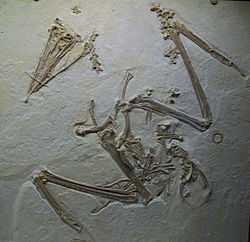Limnofregata
| Limnofregata Temporal range: Early Eocene | |
|---|---|
 | |
| Skeleton of Limnofregata azygosternon in the Field Museum of Natural History. | |
| Scientific classification | |
| Kingdom: | Animalia |
| Phylum: | Chordata |
| Class: | Aves |
| Order: | Suliformes |
| Family: | Fregatidae |
| Genus: | †Limnofregata Olson, 1977 |
| Species | |
|
†Limnofregata azygosternon (type) | |
Limnofregata ("Freshwater frigatebird") is an extinct genus of primitive frigatebird.[1] The two known species were described after fossils from the Early Eocene Green River Formation (c.49 million years ago) of Wyoming. A number of good complete and partial skeletons, some with feather impressions, are known of the type species, and L. hasegawai is known from two skulls and most of one torso.
Size
Physically Limnofregata looked similar to modern frigatebirds, but had shorter legs and wings. They stood 30 to 40 centimetres (12 to 16 in) tall when on the ground and had a wingspan of about 100 to 120 centimetres (3 to 4 ft). The beak was shorter than that of modern frigatebirds, and lacked the typical hook at the end, resembling a strong booby beak more than that of today's frigatebirds. The species differ conspicuously in size, with L. hasegawai being as much larger when compared to L. azygosternon as today's largest species of frigatebird (Fregata minor) is compared to the smallest extant one (Fregata ariel). The bill of L. hasegawai was notably larger still than that of its congener, whereas its feet were smaller, echoing a pattern found in the extant Fregata species.
Lifestyle

Limnofregata is thought to have lived like a skua. It inhabited the freshwater or brackish lakes that had in its time formed in today's Green River valley due to the uplift of the Rocky Mountains, where it fed on smaller vertebrates and probably harassed other shorebirds for food and feasted on dead fish (e.g. Knightia) during summer dieoffs due to oxygen depletion in the eutrophic lakes. Modern frigatebirds show pronounced sexual dimorphism in size, apparently to avoid competition due to different soaring behavior of male and female wings. As Limnofregata was most likely not a soaring bird, it can be expected that the sexes were much alike. It is not known if the males had a prominent throat balloon for advertising for mates as in the modern relatives, but Limnofregata throat bones at least did differ markedly from those of modern frigatebirds.
References
- ↑ Smith, N. D. (2010). "Phylogenetic Analysis of Pelecaniformes (Aves) Based on Osteological Data: Implications for Waterbird Phylogeny and Fossil Calibration Studies". In Desalle, Robert. PLoS ONE 5 (10): e13354. doi:10.1371/journal.pone.0013354. PMC 2954798. PMID 20976229.
- Olson, Storrs L. (1977): A Lower Eocene frigatebird from the Green River Formation of Wyoming (Pelecaniformes, Fregatidae). Smithsonian Contributions to Paleobiology 35: 1–33. PDF fulltext (File szie 12.5MB)
- Olson, Storrs L. & Matsuoka, Hiroshige (2005): New specimens of the early Eocene frigatebird Limnofregata (Pelecaniformes: Fregatidae), with the description of a new species. Zootaxa 1046: 1–15. PDF fulltext